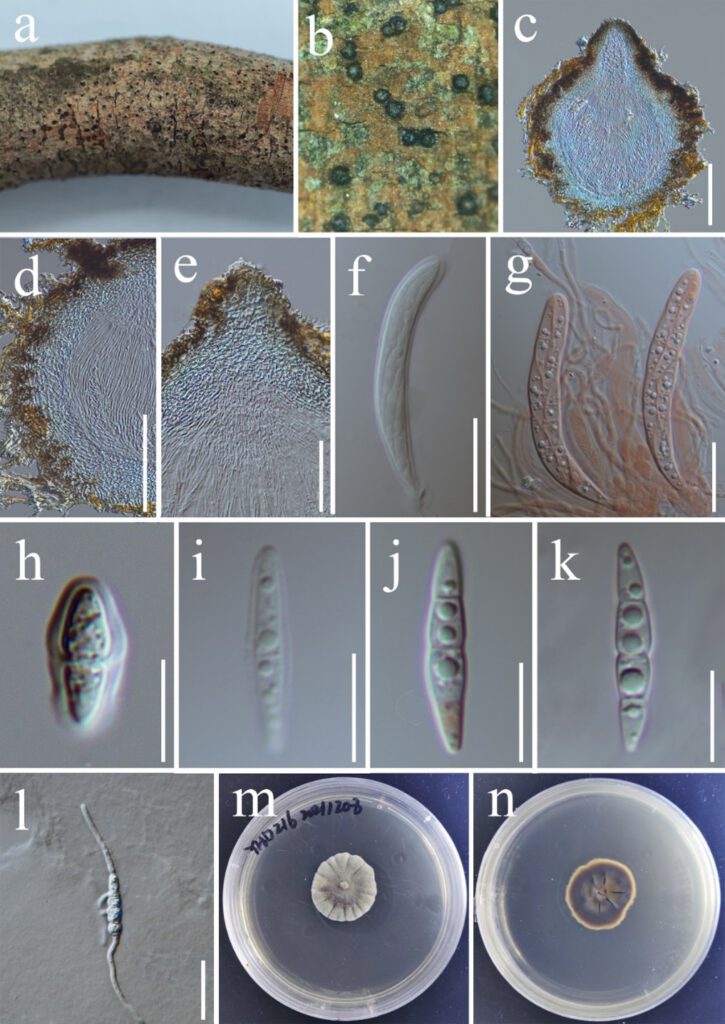Angustimassarina kunmingense H.D. Yang & K.D. Hyde
MycoBank number: MB; Index Fungorum number: IF; Facesoffungi number: FoF 11804;
Description
Saprobic on dead aerial stem of Camellia semiserrata. Sexual morph: Ascomata (162–)190–332(–333) × (119–)142–289(–300) μm (x̅ = 261× 221 μm, n = 5), scattered, gregarious, immersed to semi-immersed in the host tissue, black, globose to subglobose, ostiolate. Ostiole in the centre, crest-like, rounded, papillate, with a pore-like opening. Peridium 27–56 μm thick, comprised of 5–10 layers of cells of textura angularis, cells smaller at the base and the apex, and bigger at the side, brown to hyaline. Hamathecium composed of 1.2–2 μm (x̅ = 1.6 μm, n = 30) wide, numerous, septate, clamped, unbranched, hyaline, pseudoparaphyses, embedded in a gelatinous matrix, longer than asci. Asci (56–)60–74(–77) × (7.2–)7.5–8.7(–9.3) μm (x̅ = 68 × 8.1 μm, n = 20), cylindric-clavate, with short pedicel at the base, rounded at the apex with a minute ocular chamber, smooth-walled, 8-spored, bitunicate, fissitunicate. Ascospores (18–)20–22(–23) × (3.1)3.3–3.8(–4.1) μm (x̅ = 20 × 3.5 μm, n = 30), hyaline, smooth-walled, fusiform, dimidiate, widest at the centre and tapering toward the ends, with 1–3 constricted septate septum, filled with 1–2 guttule per cell and surrounded by a mucilaginous sheath. Asexual morph: Not observed.
Culture characteristics: Ascospores germinating on PDA within 24 h and producing germ tubes from both ends and sides. Colonies on PDA reaching 28 mm diam. after 33 days at 20 °C, nearly circular, flat, dense, radial sulcate, edge entire, smoke grey to grey-white on the surface, dark brown on the reverse and becoming grey-white at the margin.
Material examined: China, Yunnan province, Kunming city, Panlong district, on Camellia semiserrata C.W.Chi (Theaceae), 25°8′29.27″ N, 102°44′16.03″, Hongde Yang, 17 Dec 2021, (HKAS123210, holotype); ex-type living culture, KUNCC22-10799.
Distribution: China
Sequence data: ITS: ON352672 (ITS5/ITS4); LSU: ON352671 (LROR/LR5); SSU: ON352675 (NS1/NS4)
Notes: Angustimassarina was introduced by Thambugala et al. (2015). Species of this genus are broadly distributed in Belgium, Germany and Italy (Hyde et al. 2020; Phukhamsakda et al. 2020), but, have never been reported from China (Farr and Rossman 2022). Our collections from China are morphologically and phylogenetically related to Angustimassarina. Our new species Angustimassarina kunmingense resembles other Angustimassarina in terms of its ascomata, asci and ascospores characteristics and the new species was isolated from similar habitat to other Angustimassarina species (Thambugala et al. 2015). However, it is charactered by having slender asci and ascospores. The megablast search of the ITS sequence shows the highest identity with Angustimassarina species (471, 98%). In the phylogenetic analysis, Angustimassarina kunmingense formed a well-supported monophyletic clade basal to Angustimassarina species (97 ML/1.00 BY). Our phylogenetic tree was constructed using multi gene loci (ITS, SSU, LSU and EF1-α), however most taxa were not strongly supported. This could suggest that additional markers are required to achieve a more accurate identity, thus we also provide protein gene ACT and tub2 herein.

Fig. 1. Angustimassarina kunmingense (HKAS123210, holotype). a, b. Ascomata immersed on host surface c. Section through ascoma d, e. Peridium f, g. Mature bitunicate asci (g. asci stained with Congo red) h–k. Ascospores l. Gemmating ascospores m, n. Colonies on PDA. Scale bars: c = 100 μm, d = 100 μm, e = 50 μm, f = 20 μm, g = 20 μm, h = 5 μm, i = 10 μm, j = 10 μm, k = 10 μm, l = 30 μm.
